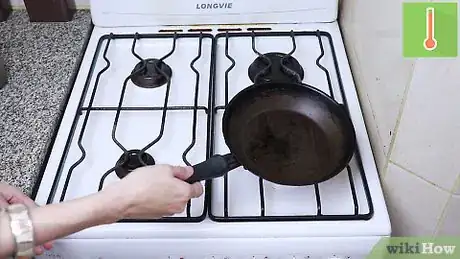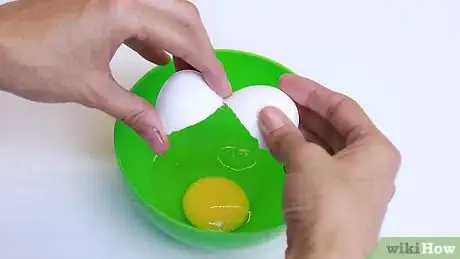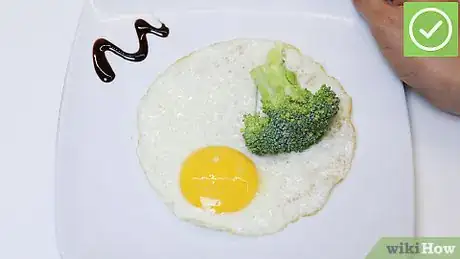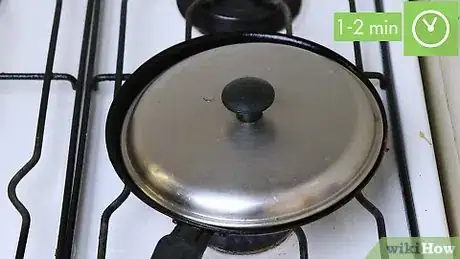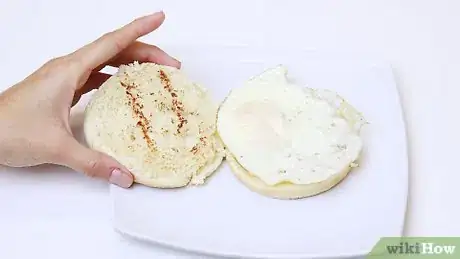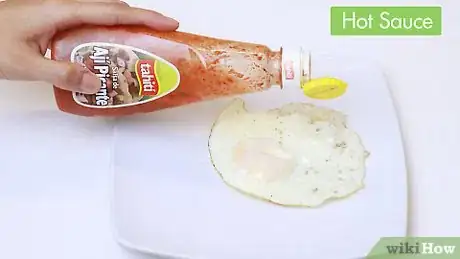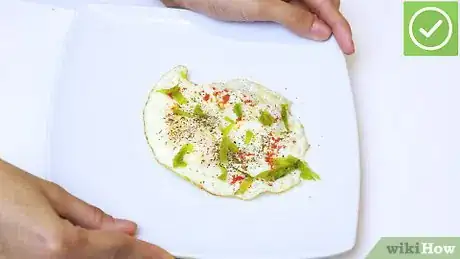This article was co-authored by wikiHow Staff. Our trained team of editors and researchers validate articles for accuracy and comprehensiveness. wikiHow's Content Management Team carefully monitors the work from our editorial staff to ensure that each article is backed by trusted research and meets our high quality standards.
The wikiHow Video Team also followed the article's instructions and verified that they work.
This article has been viewed 605,866 times.
Learn more...
Over easy eggs are fried in a pan or skillet on both sides so that the yolk thickens slightly but is still runny.[1] Learning to cook eggs over easy is just that — easy! All you'll need is a spatula, a pan, a little butter, and a few eggs. Best of all, if you're intimidated by the idea of flipping eggs, there's a way to make them without any flipping at all.
Steps
Traditional Over Easy Eggs
-
1Heat a small amount of fat in a non-stick pan. Set the stove to medium or medium-low. Drop a little of your preferred fat into the pan (use no less than one tablespoon to keep the pan slick). You're ready to proceed when you hear a quiet sizzling.
- There are many different types of fat you can use here. Just a few include:
- Butter or margarine
- Canola or olive oil
- Bacon grease (convenient if you just cooked bacon for your breakfast in the same pan)
- There are many different types of fat you can use here. Just a few include:
-
2Crack the eggs into a separate container (optional). Grab a bowl, cup or ramekin big enough to hold your eggs. Break the flat side of each egg on the rim of the container and let the contents drain into it. To save time, do this while waiting for your pan to heat up.
- Don't crack the eggs directly into the hot pan. If you do this, it's easier to break the yolks or cook your eggs unevenly. You also have less control over where they will lie in the pan.[2]
Advertisement -
3Add the eggs to the pan. Pour your eggs from the container into the hot pan. Immediately lift the handle so that the eggs slide to the far side of the pan. Wait about 10 to 15 seconds so the bottoms of the eggs have a chance to set together, then slowly lower the handle so the pan sits level on the stove. Jiggle the pan slightly to keep the eggs from sticking or carefully move them with a spatula.
- Setting the eggs together at the far side of the pan keeps the whites together in a single thick "clump" rather than having them run all over the pan. This keeps the eggs from cooking unevenly.
-
4Wait for the bottoms of the eggs to solidify. Now, let the eggs cook without disturbing them for a minute or two. You want the bottoms of the whites to be fully set (but not hard) before you proceed. Depending on your pan and the level of heat you're using, this will take anywhere from about 45 seconds to two minutes.
- Keep your eyes on the edges of the whites — they are thinner than the center, so they will solidify first. When you notice that the edges are solid, you can proceed even if the whites in the middle are still a little liquid.
-
5Flip the eggs. When the edges and bottom are solid but the white around the yolk is still clear, slip a spatula under the eggs. Lift them away from the pan and turn them over with a single quick twisting motion of the wrist. Set them down as gently as possible so you don't break the yolks. It is OK if you accidentally "fold" one of the edges under the center. This doesn't affect the finished product much.
- If you're bold, you can also flip the eggs with the pan itself. To do this, push the pan away from you and jerk the far edge up sharply. Bring the pan up to meet the egg as it turns. This is tricky, so use a spatula if you're not an experienced chef.
-
6Flip the eggs again. The second side of the egg should not cook for very long. Count to 10, then slide the spatula under the eggs and re-flip them. The "top" side of the egg should now just be barely set.
- Cooking this side of the egg for only 10 seconds is crucial. You want the tops of the eggs to solidify just enough to contain the yolks while keeping them runny.
-
7Serve. Congratulations! Your over easy eggs are done. Transfer out of the pan to a plate and serve with toast, bacon, hash browns, or other breakfast favorites.
No-Flip Over Easy Eggs
-
1Cook the underside of the eggs as normal. This method allows you to get over easy eggs without having to flip them, making it perfect if you've had problems with flipping in the past. The first few steps are exactly the same as in the traditional method. See below:
- Heat cooking fat (butter, grease, etc.) in a pan over medium or medium-low heat.
- Crack the eggs into a separate container before transferring them to the hot pan.
- Tilt the pan to gather the eggs at one end. Once they set, lower the pan flat and let them cook for about one to two minutes.
-
2Add water and cover. Pour a tablespoon of water per egg into the edge of the pan. Cover it with a good-fitting lid. The water will turn into steam and cook the top side of the egg. This will give you the characteristic film over the yolk that over easy eggs are known for without any flipping.
- If you're cooking on a flat griddle instead of a pan, pour the water right next to the egg, then set a raised lid over both the egg and the water. The lid will hold the steam next to the egg.
-
3Steam over low heat for a minute or two. Steaming doesn't cook the top sides of the eggs as quickly as contact with the pan, so you'll need to allow a little extra cooking time. The eggs are cooked to over easy when they're covered with a thin white film but the yolks are still liquid.
- Be sure to reduce the heat to low hear to prevent the bottoms of the eggs from over-cooking from the heat of the pan.
- If, after a minute or two, the eggs don't seem cooked, try turning off the heat and letting the residual heat warm them a little longer.
-
4Serve and enjoy. You don't need to flip the eggs a second time with this method. Simply remove the lid (carefully, as to avoid steam burns) and transfer the eggs to a plate.
Serving Suggestions
-
1Season the eggs with salt and pepper. Over easy eggs have a rich, almost creamy flavor on their own, but this doesn't mean they need to be eaten plain. Salt and pepper are extremely common condiments for eggs, complementing the natural egg-y flavor perfectly. Don't serve eggs without a pair of shakers at the table.
- Some chefs like to season their eggs with salt and/or pepper in the pan. If you want to do this, sprinkle the seasonings on while the bottom sides of the eggs are cooking (before flipping them for the first time).
-
2Eat the eggs over toast. Toast — white or wheat — goes great with eggs. Its crispness perfectly compliments the naturally soft texture of eggs. Best of all, when you're eating over easy eggs, you can use the toast to soak up the runny yolk. Alternatively, make an egg sandwich with your other favorite breakfast ingredients.
- Substitute crisp fried hash browns for toast whenever desired.
-
3Use hot sauce. Eggs have a natural mild flavor, which makes them great candidates for spicy condiments. Hot sauces (e.g., Tabasco, etc.) drizzled over a serving of eggs can transform them from a run-of-the-mill dish into something with a little more pizzazz. Just be sure not to use too much.
-
4Try unconventional herbs and spices. If you're willing to get a little adventurous, you can try seasoning your eggs with ingredients that you won't typically see at your neighborhood diner. The following herbs and spices each give their own unique taste to egg dishes. Try adding a small amount to your eggs at first — if you like the taste, feel free to add more!
- Dill
- Cayenne pepper (use a light dusting)
- Basil
- Sundried tomatoes
- Sturgeon or whitefish
- Caviar
References
About This Article
To cook an over easy egg, start by heating oil or butter in a small pan over medium heat. Once the oil or butter is hot, crak the egg into the pan. Let it cook for a few minutes, or until the bottom solidifies and turns fully white. Then, use a spatula to gently flip the egg over, being careful not to break the yolk. After 10 seconds, flip the egg over again so that the yolk doesn’t overcook.Transfer the egg to a plate and serve.
